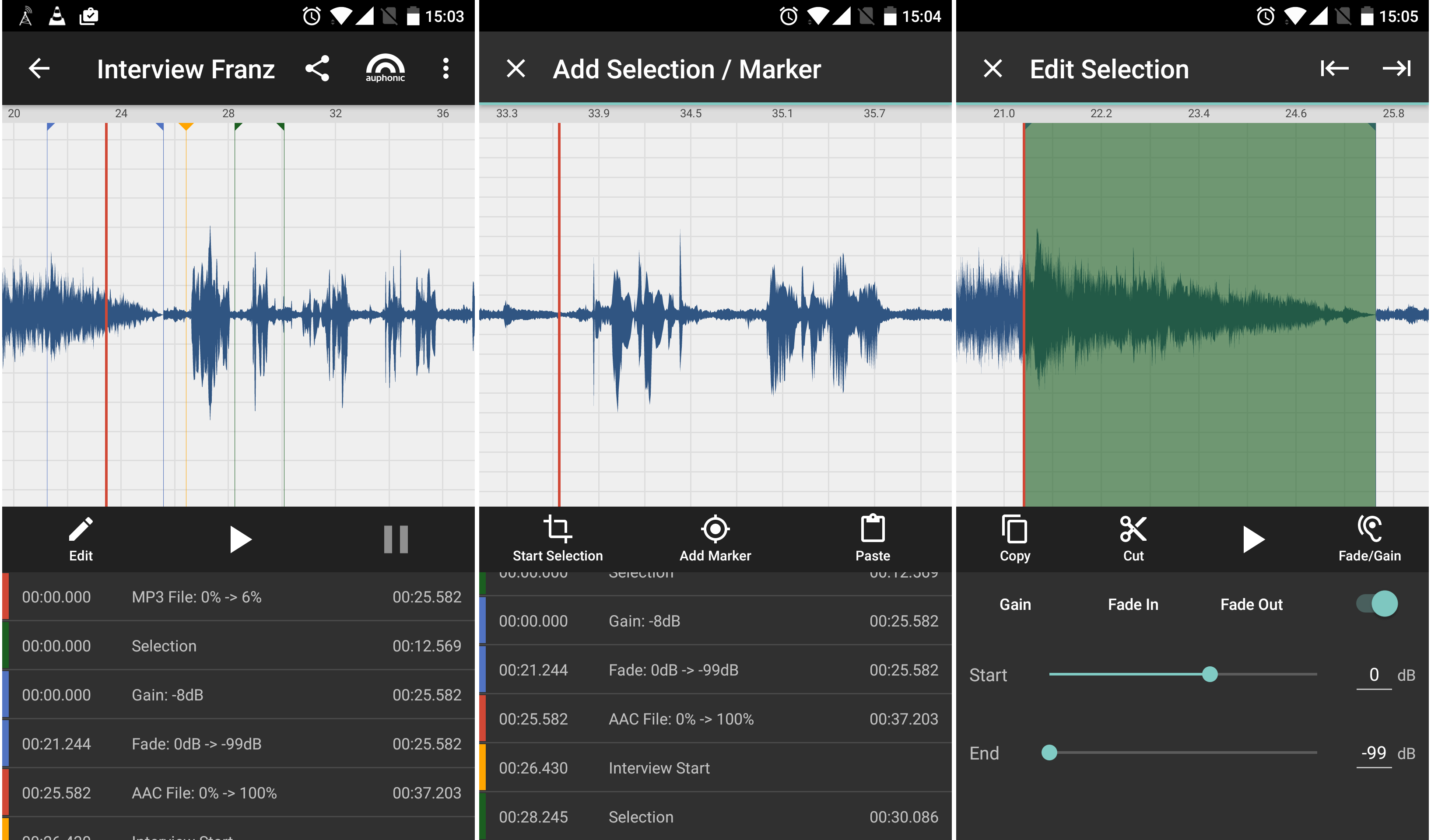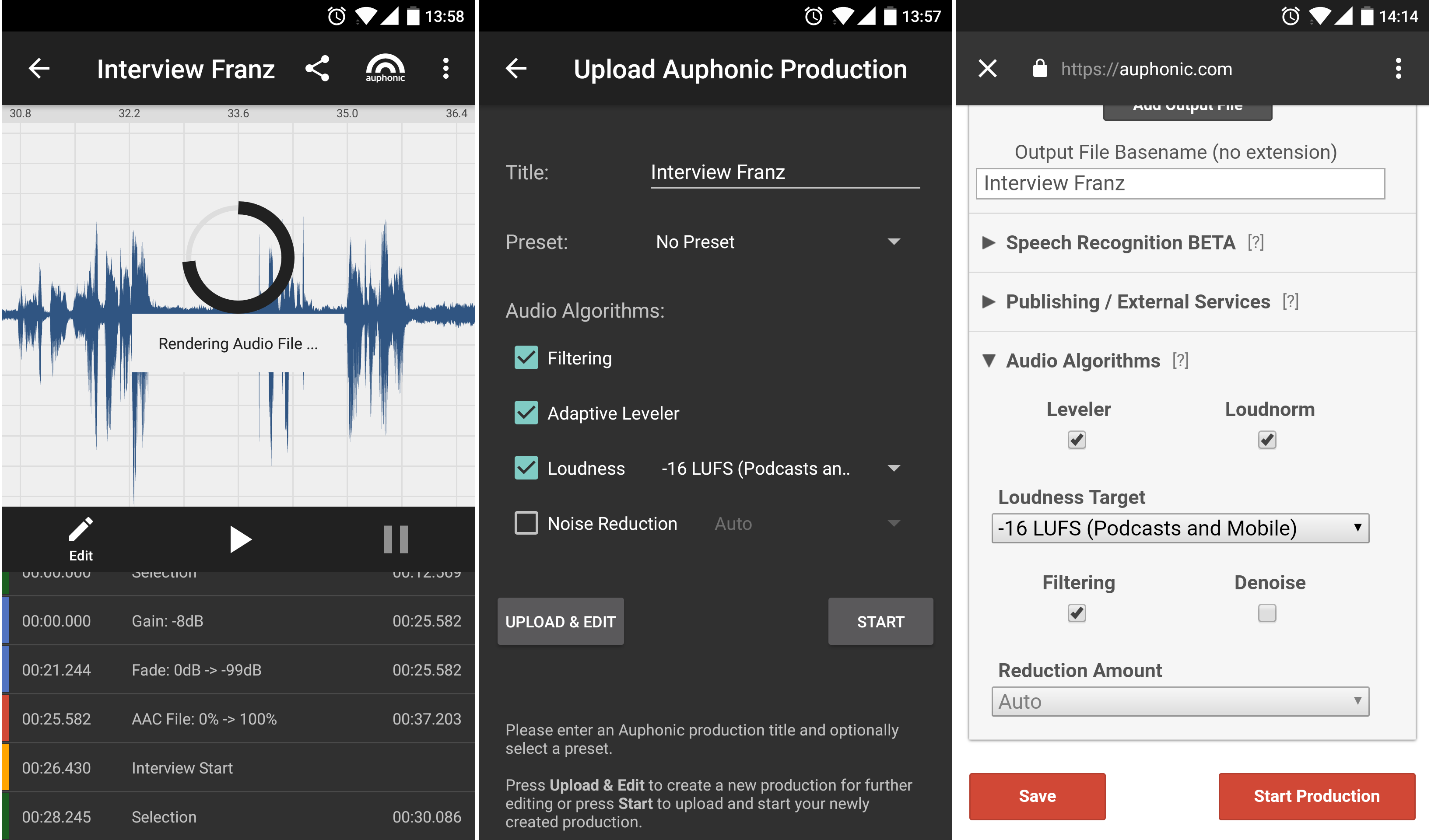Auphonic Edit: Audio Editor and Recorder for Android
Auphonic Edit is a non-destructive, mobile audio editor and recorder with focus on ease of use, high-quality audio and stability.
In combination with the integrated Auphonic Web Service, it’s possible to post process, encode, tag and publish your podcasts, interviews, music recordings on the go with a single click.
Auphonic Edit in Google Play Store (free):
https://play.google.com/store/apps/details?id=com.auphonic.auphonicrecorder
Attention
Auphonic Edit is not a full-featured Digital Audio Workstation (DAW).
It is optimized for simple mobile recording, editing and for exporting mobile audio
to our Web Service!
Integrated Audio Recorder
The focus of the integrated recorder is robust and high-quality recording:
It is possible to use the internal microphone or any external USB audio interface/microphone for professional audio quality and all default Android pre-processing is deactivated to get the raw audio signal.

The recording interface displays the current maximum peak level, available recording time (storage), you can add and edit Chapter Markers and it’s possible to record in background while using other Android apps or while the screen is turned off.
You can select the recording samplerate (Automatic, 44100 Hz or 48000 Hz), input channels (Mono or Stereo)
and we also support external storage devices (USB sticks, SD cards, external hard disks, etc.)
during recording and when editing audio files.
The recorded signal is encoded in an uncompressed WAV or compressed AAC format (Mono: 128kbps, Stereo: 160kbps), written to disk every audio buffer so that no data loss happens if the app gets killed.
Note
For our compressed AAC format, we don’t use an MP4/M4A container, because it might get corrupted in the case of a crash.
We use the AAC ADTS format to always write a valid audio stream, even if the app gets killed.
Mobile Audio Editor
Existing audio editors for iOS and Android are often very confusing and try to include as many features as possible. They borrow heavily from Desktop software idioms, and are hence visually cluttered and have many non-discoverable elements.
—Jamie Bullock, see blog post iPad Audio Editor Wireframes
Auphonic Edit implements the minimum amount of features required to cover the most common audio editing tasks, conforming to standard native UI idioms of Android.

- Waveform Display
The main interface is a full waveform display of the audio signal, where it’s possible to zoom in/out horizontally (time) and vertically (levels), to create selections, to seek and to scroll in the audio project.
- Non-destructive Editing
First you have to create a selection (Edit -> Start Selection or Long Tap -> Start Selection), then it’s possible to cut files with automatic crossfades or copy/paste selections (also between different audio projects).
We always keep the original audio files, therefore you can restore cut regions/files (if you don’t delete the whole audio project!).- Navigation Markers
Markers, Selections and File Object are displayed in the markers list below the waveform.
Click on the marker/selection/file start (or end) time for exact audio navigation. Long Tap on list items to show more information (file/marker details), to delete markers/selections/files, to restore cuts, change selections, change titles, etc.
Markers will be exported as Chapter Markers if you create an Auphonic production.- Volume Gain and Fade In/Out
It’s possible to adjust the gain of a selection and to add fade in/out etc.
- Audio File Import
You can import any audio file format supported by Android, from your storage devices or from other apps.
We automatically apply down/upmixing and realtime resampling to fit the current audio project settings, using the high quality resampling algorithms of SoX.- Tablet Layout and Mouse Support
A horizontal editing layout is available for tablet users and it’s also possible to use an external mouse for audio editing.
- Integrated Help
Select Show Help in the menu bar (top right) to get an initial overview on how to use Auphonic Edit.
Rendering, Sharing and Auphonic Web Service Export
The audio project can be rendered (saved) into an uncompressed WAV or compressed AAC (inside M4A/MP4 container) file format and shared with any Android app or exported to the Auphonic Web Service.

- Share Audio
Click on the Share Button to render and share the audio project with any other Android app.
- Save to File
Select Save to File in the menu bar (top right) to render and save the audio project to a local file on your device.
All rendering is done in background and a notification is shown upon completion.- Auponic Export
Click on the Auphonic Button to render and export the audio project to the Auphonic Web Service:
Upload audio files, including Metadata and Chapter Marks, in the background directly from Auphonic Edit to our web service. Select one of your Presets to perform audio post processing (loudness, leveling, noise reduction - see Audio Algorithms), Encoding/Tagging, Speech Recognition and trigger Publishing with one click directly from your phone.
All rendering, uploading and processing is done in background and a notification is shown upon completion.